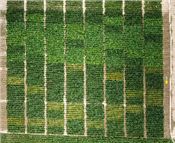Why We Need A Soybean Variety That Cannot Fix Nitrogen
JOHN LOVETT
FAYETTEVILLE, ARKANSAS
Breeding a modern soybean that does not “fix” its nitrogen may initially seem counterintuitive. However, it is part of the grand plan to assess nitrogen fixation in new high-yielding varieties and potentially reverse the decline in grain protein content seen over the past 30 years.
Although U.S. soybean yield increased by about 14 bushels per acre between 1986 and 2019, average grain protein concentration decreased by about 2 percent. In typical soybean plants, root nodules interact with microbes in the soil to fix nitrogen from the air, eliminating the need to apply nitrogen fertilizer.
With support from the United Soybean Board, researchers with the Arkansas Agricultural Experiment Station in collaboration with scientists at Kansas State and the University of Georgia have bred high-yielding soybeans in Maturity Groups 4 and 5 that do not create root nodules interacting with microbes and source nitrogen from the atmosphere.
The experiment station is the research arm of the University of Arkansas System Division of Agriculture. The new “non-nod” soybeans will be released to the USDA Germplasm collection this winter and will be available to researchers soon after. The advance in agricultural science is that they are genetically similar to modern-day, high-yielding soybeans with nodules that do fix nitrogen.
“Having non-nodulating soybean varieties with similar yield potential when fertilized with nitrogen as nodulating cultivars is key to understanding potential crop nitrogen limitations, developing management strategies to improve grain protein concentration, and identifying soybean varieties with high rates of nitrogen fixation,” said Larry Purcell, Distinguished Professor of crop physiology and Altheimer Chair for Soybean Research at the University of Arkansas.
Purcell said he has worked with nitrogen fixation for most of his career but began research on breeding a modern “non-nod” soybean about five years ago with Kansas State University professor and soybean breeder William Schapaugh Jr. The United Soybean Board- supported program to breed the modern, high-yielding “non-nod” soybean in all maturity groups is in its third year.
“From strictly a biological perspective, it's a fascinating symbiosis,” Purcell said. “You have the soybean that needs the nitrogen, the Bradyrhyizobium japonicum that needs the sugars and everything else the plant provides, in addition to an enclosed environment in that nodule where the magic takes place. The close coordination is a beautiful symbiosis that really caught my attention.”
Bradyrhyizobium japonicum is a rhizobium, a soil bacterium that converts atmospheric nitrogen into organic forms the plant can use.
Soybeans are a $1.5 billion crop in Arkansas, valued for their high oil and protein concentrations, according to the 2022 Arkansas Agriculture Profile. Purcell noted that about 35 to 40 percent of the bean is protein and about 20 percent is oil. Soybean plants take up mineral nitrogen from the soil when available to build high protein levels, but they also form nodules on roots in symbiosis with rhizobium bacteria to obtain atmospheric nitrogen, especially when soil nitrogen is inadequate.
Most of the soybeans grown in Arkansas are in Maturity Group 4.
Agricultural research stations in Georgia, Kansas, Minnesota, and Nebraska have worked to breed “non-nodulating” soybeans and their nodulating pairs in Maturity Groups 0, 1, 2, 3, 6, 7, 8 and 9.
Non-nod varieties have been around since the 1950s in backgrounds of varieties including Chippewa (MG 0), Williams82 (MG 3), Lee (MG 6), and Hardee (MG 8), but prior to this research there were no non-nods in modern, high-yielding varieties. For example, non-nodulating Lee, when fertilized heavily with nitrogen has a yield potential of about 50 bushels per acre, Purcell noted. A modern, high-yielding genotype under optimum growing conditions has a yield potential of 75 to 80 bushels per acre.
“The United Soybean Board saw that the lack of high-yielding non-nods was a real limitation for advancing genetic research that looks to improve the protein concentration in grain,” Purcell said. “They have generously funded this national program to develop ‘non-nod’ lines along with their nodulating isolines.”
Purcell said that the isolines, or nearly identical twin lines, differ primarily by just one gene that is essential for soybean to fix nitrogen. The isoline allows researchers to determine the fraction of atmospheric nitrogen that comes from the interaction with rhizobium compared to the nitrogen from the soil.
“We knew the potential was not there genetically for these old non- nods to be able to adequately represent high-yielding genotypes that we grow today,” Purcell said.
Nitrogen fixation potential differs among soybean varieties, and nitrogen is critical to both yield and protein concentration, Purcell said. He added that the key to maximum nitrogen uptake is having the “proper genetics and proper environment” to take advantage of the symbiosis between the plant and rhizobium.
Field trials on the "non-nod" soybeans and their high-yielding isolines were held at the Division of Agriculture’s Pine Tree Research Station in St. Francis County. To see if the “non-nod” varieties could produce yields as good as their nodulating twin if fertilized, researchers applied the equivalent of 300 pounds of nitrogen fertilizer to "non-nod" plots and no nitrogen on other "non- nod" plots of the same variety to serve as a control.
“If it only differs for that nodulating trait, we would expect the yields to be similar when plenty of nitrogen was provided. And that’s been pretty much what we have seen,” Purcell said.
Last year at Pine Tree, the modern "non-nod" plants with nitrogen fertilizer added produced about 65 bushels per acre, the same as their nodulating twins. Experiments at Kansas and Georgia had similar results.
Of course, a farmer does not want to use a “non-nod” line because of the added expense of nitrogen fertilizer.
"This is strictly a tool for being able to do large-scale field research to evaluate the contribution of nitrogen fixation to soybean and indirectly look to determine the importance of nitrogen fixation is to grain protein concentration,” Purcell said.
Purcell’s research colleagues on the non-nodulating soybean project include Aaron Lorenz at the University of Minnesota, George Graef at the University of Nebraska, William Schapaugh Jr. at Kansas State University, Zenglu Li at the University of Georgia and Andrea Acuna Galindo with the Arkansas Agricultural Experiment Station. ∆
JOHN LOVETT: University of Arkansas

An aereial view of nodulating and non-nodulating soybean plots, with and without nitrogen fertilizer, at Pine Tree Branch Research Station in 2021. The light green plots are "non-nod" soybeans without added nitrogen.
U of A System Division of Ag photo

Larry Purcell, Distinguished Professor of crop physiology for the Arkansas Agricultural Experiment Station.
U of A System Division of Ag photo